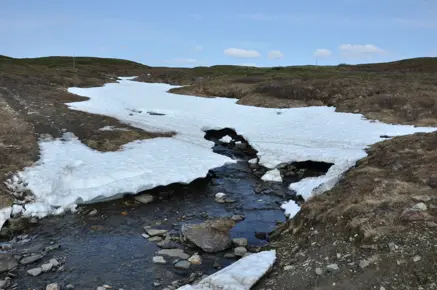BIOFUN: Climate-induced changes in the biodiversity and function of Arctic/alpine streams and their landscapes
KEY POINTS- Aquatic life in streams are inherently connected to the surrounding landscapes
- Vegetation development in Arctic/alpine landscapes promoted by climate change may reduce nutrient inputs from land to surface waters, causing changes in structural and functional biodiversity of streams.
- Stream biodiversity changes have the potential to alter the beneficial (omega-3 fatty acids) and harmful subsidies (cyanotoxins) that streams provide to terrestrial food webs.
Participants
More related research
Global goals
- 6. Clean water and sanitation
- 14. Life below water
- 15. Life on land
Short summary
BIOFUN aims to assess the effects of climate-induced landscape changes on the biodiversity and ecological functions of Arctic/alpine streams, and model how sequestration of C, N, and P by terrestrial vegetation contributes to the observed nutreint declines (oligotrophication) in surface waters.
The northern regions of the globe are warming at more than twice the global rate, and the subsequent transformation of landscapes is resulting in rapid ecological and biodiversity change in inland waters. This includes subarctic Scandinavia, where landscapes are rapidly greening, tree-lines are expanding, glaciers are melting, and ecosystems are changing.
BIOFUN focuses on the ecological consequences for stream biodiversity (structural and functional) of the projected, warming-induced transition in vegetation cover, i.e. from tundra dwarf-shrubs and grasses to mountain birch forest. BIOFUN will provide new fundamental knowledge on all aspects of stream biodiversity, including both invertebrates, algae, and heterotrophic microorganisms, and on the fluxes of nutrients, omega-3 fatty acids, and highly potent cyanotoxins across the stream-riparian interface. Lastly, BIOFUN will develop models that quantify the expected sequestration rates of carbon (C), nitrogen (N), and phosphorus (P) in Arctic/alpine landscapes. These models will link scenarios for future landscape change to fluxes of nutrients and key biomolecules across the streams-riparian interface. Ultimately results will contribute to a mechanistic understanding of the observed climate change-induced oligotrophication of Arctic/alpine freshwater ecosystems and to improving landscape-scale carbon budgets and assessment criteria for Arctic/alpine streams.
Project objectives
- To quantify structural and functional diversity changes of key organism groups (invertebrates, benthic algae, heterotrophic microbes) in Arctic/alpine streams across elevation gradients.
- To quantify the fluxes of CNP, omega-3 fatty acids, and cyanotoxins across the stream-riparian interface.
- To use satellite images (Normalized Difference Vegetation Index, NDVI-data) and plot scale NDVI-images to assess relationships between the greening of alpine catchments and on-the-ground plant biomass.
- To develop models to estimate rates of CNP-sequestration in Arctic/alpine landscapes through plant biomass accumulation.
Implementation
BIOFUN applies a space-for-time design and novel techniques to study the climate-induced changes in structural and functional biodiversity (invertebrates, algae, and microbial heterotrophs) of Arctic/alpine streams across elevation gradients, thus mimicking future climate warming and landscape alterations, i.e. from tundra vegetation through willow and mountain birch stands and into the closed mountain birch forests. BIOFUN also quantifies the beneficial (omega-3 highly unsaturated fatty acids) and harmful subsidies (cyanotoxins) that streams provide to riparian zones along the elevation gradients.
BIOFUN also uses already collected samples of tundra vegetation to establish relationships between NDVI and plot-scale plant biomass, as well as their concentrations of C, N, and P. These relationships are then used to upscale CNP-sequestration on a landscape scale.
Participants from SLU
